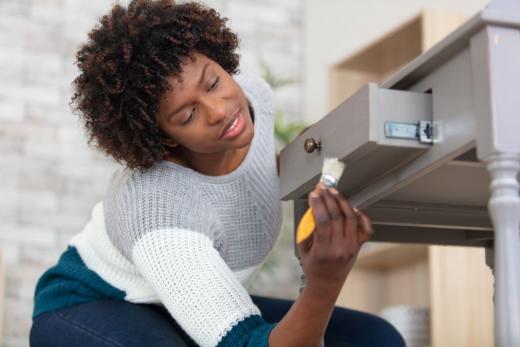How To Professionally Paint Kitchen Cabinets in Less Than an Hour
How To Professionally Paint Kitchen Cabinets in Less Than an Hour
- by PropHunt Admin
- On 19-05-2022
- at 4:58 PM

You don't have to be a professional to paint beautiful kitchen cabinets. But the surprising thing is that 99 percent of homeowners still employ contractors, which can cost up to 20 times the price of a DIY solution.
In fact, we spent just GHC800 on materials and we now have our kitchen.
Although home renovation is one of those homecare undertakings that can drain your bank account, the long-term benefits are well worth it. It's even more worthwhile when you decide to renovate your kitchen, given the beauty, glitz, and impact it has.
In this article, I'll walk you through the simple 7-steps process of how to paint kitchen cabinets to look like a million kitchens.
How to paint kitchen cabinets
1. Prep the condition of your kitchen cabinets.
This is the foundation of your painting process and any mistake at this stage will render your effort amateur. You might want to check and repair any existing damages before starting the paint.
After checking and repairing any damage, empty the cabinets, and clear off the counters. Relocate other furniture to another room or completely cover them with drop cloths.
Then, gently remove and label the doors and drawer faces. Use screwdrivers as it’s easy to use. For easy identification, use a marker to number the hinge holes, inputting the same number on the cabinet. That way, it's easier to put them back together again.
Tape rosin paper over the counters and flooring, and plastic sheeting over the backsplash, windows, fixed appliances, and internal doorways to protect the rest of the house from dust and fumes.
Remember to cover the walls around the cabinets and set a DIY station for painting doors, drawers, and shelves.
2. Clean the cabinet
The next stage on how to paint the kitchen cabinets is to clean the cabinets. This goes to new kitchen cabinets as well. Clean with denatured alcohol, degreaser solution or Crud Kutter, wiping with a cloth or rag. This removes dirt, oils, and grease that could prevent a perfect finish.
3. Sand the cabinets
Slightly sand your cabinets to even the rough patches. We recommend using a medium medium-grit sanding sponge. The wood should end up feeling glass-smooth. If you sand properly, you will create a texture to help the paint stick.
4. Prime the cabinet boxes
It's finally time for the primer. Use a stain-blocking primer if the cabinets are highly stained, as it cures rapidly and seals knots and other surface imperfections that might bleed through the topcoats. However, in most cases, stain-blockers aren't required, and an oil-based or 100 percent acrylic latex or bonding primer will suffice. These primers are specially formulated to do two things very well: stick and be stuck to. Despite its higher cost, it's designed to work better.
Roll on the primer with a mini roller and a brush. Don’t push in too heavily or you’ll start seeing roller and brush marks. The primer may appear wet after drying, letting excess primer fall to the floor. Removing the excess primer can be done with a roller or brush while the primer is still wet.
5. Sand again
After the primer is dry, sand the flat surfaces with 220-grit paper and a medium-grit sanding sponge. If you notice any holes while sanding, squeeze a thin bead of latex caulk into any open seams.
Vacuum all the surfaces, and wipe them with a tack cloth.
6. Paint kitchen cabinets
You’re finally ready to paint! If you’re using roughly the same shade as the current colour, two coats of paint are enough to look good and have enough coverage. Painting over a dark finish with a light colour is tougher and could require three coats. Break out a new brush for each coat. It's easier following the steps below;
- Fill the paint tray with trim and cabinet enamel paint and paint the brush and roller. Cut in along the edges with the brush, pushing the paint into the corners and avoiding roller strokes. When possible, use the roller to apply enamel paint to the broad flat area.
- Apply the paint to the cabinet interior with a smooth-surface small roller for a slightly rough, orange-peel look.
- While you wait for the first layer to dry, cover the brush and roller with plastic bags to keep them from hardening.
- Between applications, lightly sand the surfaces, making sure to wipe away any debris.
- Give the cabinet a second coat. Hopefully, this coat will give you a flawless, uniform finish where the wood will not show through.
Repeat the same process to paint the doors, drawers, and shelves. Do read the paint can to find out drying times.
7. Put back all the pieces
Reattach the door and drawer fronts once the second coat has dried. It can take anywhere from an hour to two hours to dry. Repack the cabinets after two weeks to ensure optimal dryness.
Remove the tape covering the door numbers, install the hinges and knobs, and hang the doors in their original locations.
Replace or add new drawer pulls, then reinstall each drawer.
How to Paint Kitchen Cabinets in Summary
How to paint kitchen cabinets is less stressful when you have the right information. You can always DIY or hire a professional. Below is a recap of a step by step guide on how to professionally paint kitchen cabinets in less than an hour.
-
Prep the condition of your kitchen cabinets.
-
Clean the cabinet
-
Sand the cabinets
-
Prime the cabinet boxes
-
Sand again
-
Paint kitchen cabinets
-
Put back all the pieces
FAQs
Q: What kind of paint do professionals use to paint kitchen cabinets?
A: Many professionals now use latex paint, citing the improvements to the formula and the as-good-as finish they can get on most surfaces. The third type of paint is actually preferred for cabinets, the hybrid enamel.
Q: How much does it cost to paint kitchen cabinets?
A: The average cost of painting kitchen cabinets is ₵800 for cabinets. This usually averages out to a cost of ₵2,000 for a medium-sized kitchen. However, the cost commonly ranges from ₵3000 to ₵5,000.
A: Is it better to spray or brush paint kitchen cabinets?
Ideally, spray painting cabinets is the most sought after method today. With a spray gun, you get a finish that is second to none, and it's faster and more efficient than anything else.
Q: Do professionally painted cabinets hold up?
A: With proper care of professionally painted kitchen cabinets, you can expect your newly painted cabinets to last 8-10 years. Nevertheless, there are a few things that can drastically shorten this timeframe, leaving you to repaint them 3-4 years later.
Q: Do you need to sand cabinets before painting?
A: You should sand cabinets before beginning your how to paint kitchen cabinet project to give the new paint a good surface to grip. But you don't need to sand bare wood. If your cabinets have a factory finish, sand lightly with 120-grit sandpaper or a sanding sponge.
Q: How Many Gallons Of Paint Do I Need To Paint Cabinets?
A: Using a primer and paint for most cabinet refinishing projects should amount to 2-3 gallons and 3-5 gallons, respectively.

 French
French




